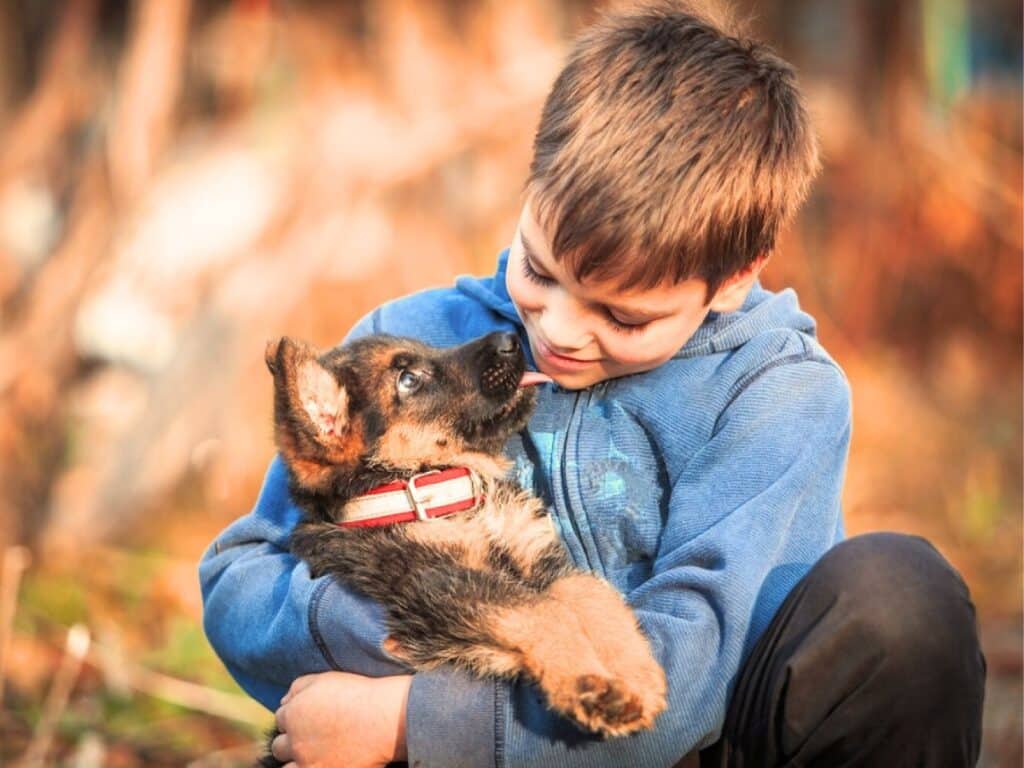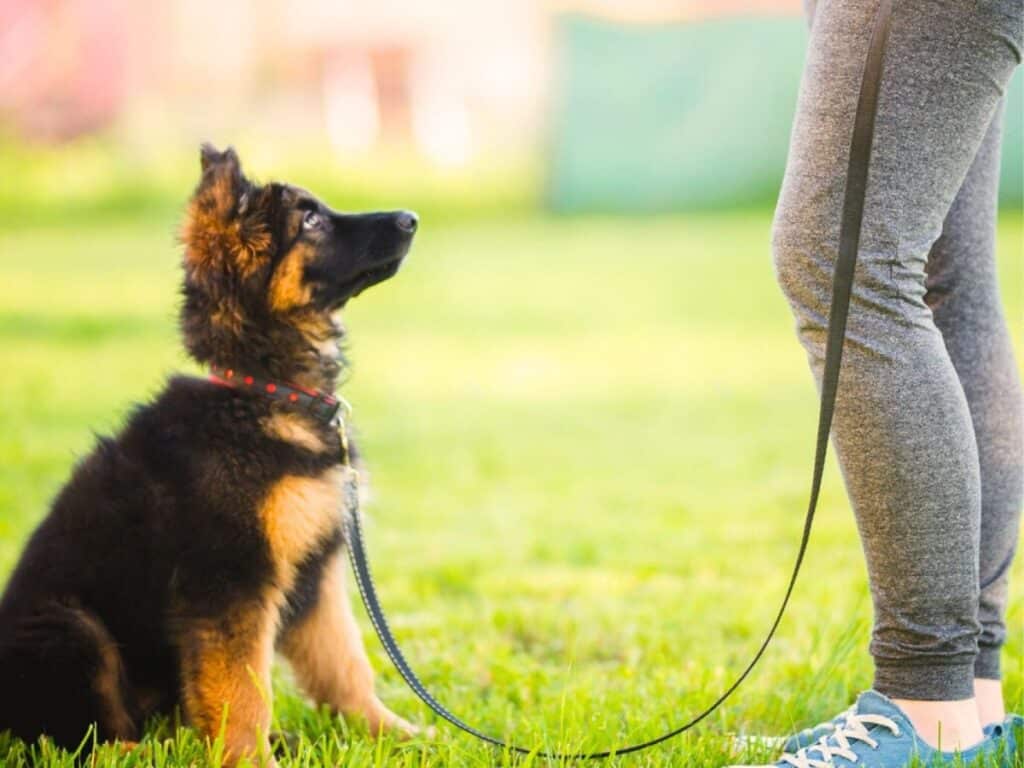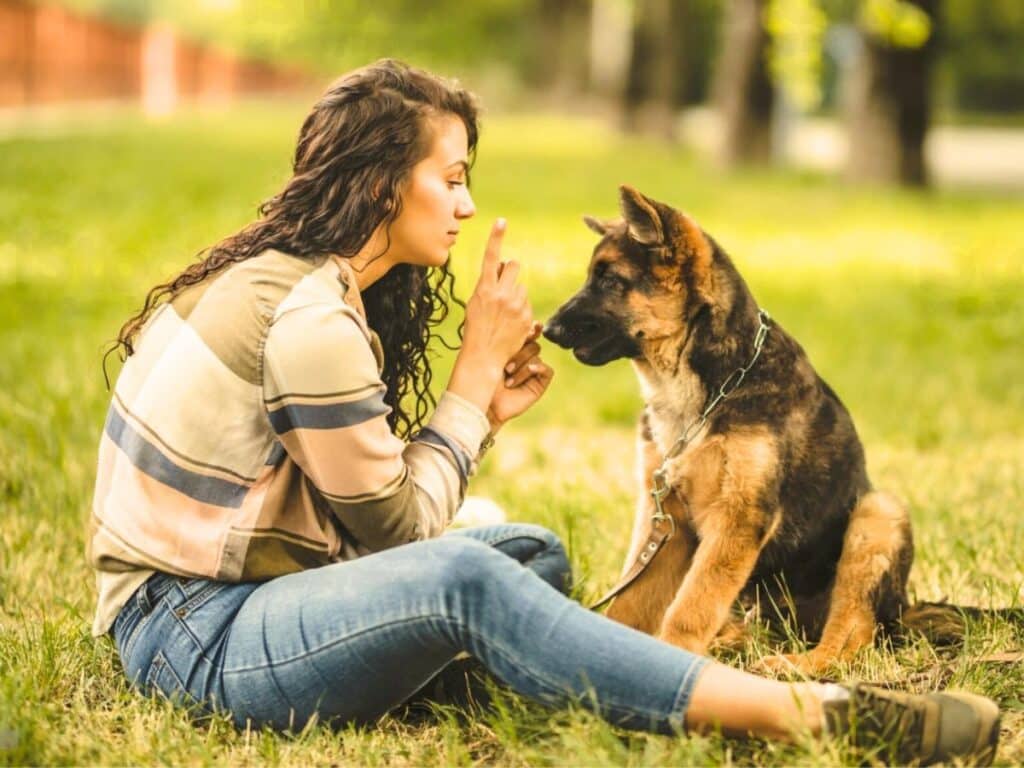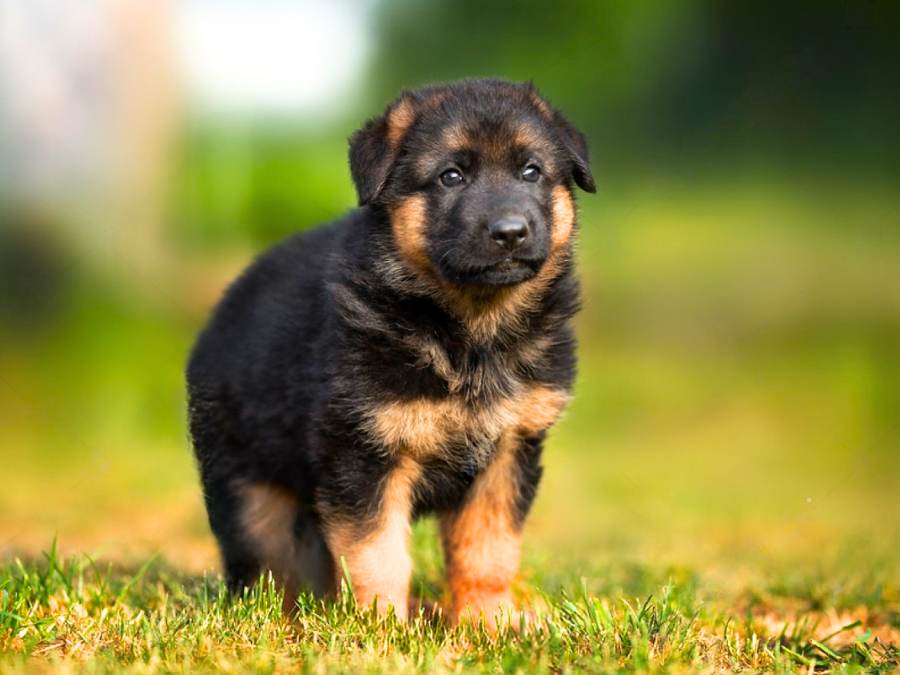The process of socializing a German Shepherd puppy involves more than just exposing them to different people and environments; it’s about creating positive associations that shape their future behavior.
Several canine studies have identified the critical puppy socialization period as being between 3 and 12 weeks of age.
During this stage, it only takes a small amount of experience to affect a puppy’s later behavior. Assuming you’ve brought home your puppy once he’s at least 8 weeks old, you’ve only got a few weeks left to take advantage of this critical time in your pup’s development.
So in this guide, we’ll explore effective strategies for socializing your German Shepherd puppy while highlighting common pitfalls to avoid.

Download the German Shepherd Socialization Checklist. This comprehensive 8-page guide includes an exhaustive list of people, sounds, surfaces, objects, and environments essential for properly socializing your puppy.
What Is Puppy Socialization?
Socializing your puppy is all about teaching them that the world is a safe place and that new experiences, people, and other animals don’t have to be scary.
This critical socialization period for a GSD puppy typically occurs during the first few months of the puppy’s life, roughly between 3 weeks and 12 weeks of age.
During the socialization process, puppies are introduced to different environments, sounds, sights, smells, surfaces, and people.
That might sound like a lot for a young puppy to handle, but don’t worry: Your dog’s brain is most capable of processing and accepting all these new experiences during the first 12 weeks of their life.
This timeframe (3-12 weeks) is commonly called the puppy socialization period, during which pet parents should aim to expose their puppy to as many different positive experiences as they can.
The aim is to build their confidence and teach them how to interact with the world around them appropriately.
According to the American Veterinary Society of Animal Behavior, improper socialization of your German Shepherd puppy can lead to behavior problems, fearfulness, and aggression later in life.
When a puppy is introduced to new sights and sounds positively, he’ll grow up smarter, healthier, and more confident. In other words, he’ll take everyday situations like hearing a car horn and meeting a heavily bearded man all in stride.

Want a Step-by-Step Socialization Plan?
You’re already on the right track by learning how to socialize your German Shepherd — but if you want to follow a clear, age-based plan with checklists, real-life examples, and practical activities, I’ve put it all together in an easy-to-follow guide.
It’s called “How to Socialize Your German Shepherd”, and it’s designed to walk you through exactly what to do — whether you’re working with a shy puppy or a reactive adult.

It’s beginner-friendly, and packed with tips you can use right away — from where to take your GSD, to what to expose them to, and how to handle fear or hesitation.
This guide takes out the guesswork and gives you a confident plan to follow.
Instant Download · Just $4.99
Why is Socialization Important for German Shepherds?
Socializing is crucial for your furry friend’s growth and happiness. Think of socialization as a key ingredient in raising a well-behaved, confident German Shepherd.
It’s not just about making them friendlier; it’s about helping them become well-rounded companions.
Here are some key reasons why GSD puppy socialization is essential:
- Making friends: Regular socializing means your German Shepherd will be more at ease around other pets and people.
- Relaxed, calm vibes: It also cuts down on their nerves in new places or situations.
- Good behavior: Dogs that get out more tend to have fewer behavioral issues. No one wants a jumpy or overly timid pooch.
- Happy, well-adjusted adult dogs: GSD puppies that mix and mingle grow up into more adaptable adult dogs.
- Smooth interactions: Socializing teaches your GSD how to read and respond to social signals from dogs, humans & other animals.
- A happy you: If you take the time to socialize your puppy, you’ll get to enjoy the full spectrum of life with your furry friend without having to worry about how your pup may respond to new situations/people/dogs.
How To Socialize a German Shepherd
I exposed my GSD Rocky to items in each of these six categories during the first weeks and months he was home:
- new people
- new animals
- new objects
- new sounds
- new environments
- types of touch/handling
Socializing Your GSD to New People
- Begin by introducing your puppy to family members and close friends. Ensure these interactions are calm and positive.
- Start with introducing your pup to one person, then slowly increase the number over time.
- Encourage new people to offer treats or toys to your puppy.
- When your puppy exhibits calm behavior around new people, reward them with treats and praise.
- Introduce your puppy to people of different ages, genders, and appearances.
- Some puppies may be initially shy or nervous. Allow them time to acclimate, and avoid forcing interactions.

Socializing Your Puppy to New Animals
- If you have other pets at home, start by introducing your puppy to them in a controlled and supervised environment.
- When introducing your puppy to a new animal, choose a neutral territory where neither animal feels territorial.
- Keep both animals on a leash during the first introduction.
- Use treats and positive reinforcement to reward calm and friendly behavior from both animals.
- Introduce the animals gradually, allowing them to observe each other from a distance before getting closer.
- Always closely supervise interactions between your puppy and other animals.
- If possible, expose your puppy to different types of animals, such as cats, rabbits, or smaller mammals.
Socializing Your Puppy to New Objects
- Begin by introducing your puppy to everyday items like shoes, bags, and household tools.
- Allow them to explore and get comfortable with one item before introducing the next item.
- Play with the new objects in the puppy’s presence to make the experience enjoyable.
- Whenever your puppy shows curiosity or investigates a new object, reward them with treats and positive reinforcement.
- Take your puppy outdoors to experience natural objects like leaves, grass, and branches.
- Take your puppy to different environments with new objects, such as pet-friendly parks or outdoor events.
Socializing Your Puppy to New Sounds
- Begin by exposing your puppy to common household sounds, such as the vacuum cleaner, doorbell, television, and kitchen appliances.
- Start with the sound at a low volume and gradually increase it.
- Encourage your puppy to associate new sounds with positive experiences by offering treats and praise during exposure.
- Introduce your puppy to various types of sounds, including high-pitched, low-pitched, sudden, and continuous noises.
- Take your puppy outdoors to experience natural sounds like birds chirping, leaves rustling, and distant traffic.
- Consider using sound simulation apps such as Pupford, designed for pet socialization.
- Take your puppy to public places with ambient noise, such as parks, markets, or cafes.

Socializing Your GSD to New Environments
- Begin by gradually introducing your puppy to different areas within your home. Allow them to explore rooms, stairs, and various surfaces.
- Use a leash to control your puppy during the first few walks in new environments.
- Take your puppy to places where they experience different settings, like parks, pools, ocean, lakes, or grocery stores.
- Take your puppy to pet stores where they can experience different sights, sounds, and smells while being around other animals.
- Walk your puppy on various surfaces, including grass, pavement, sand, and gravel.
- Gradually introduce car rides, making them short and positive.
- Attend outdoor events or markets where your puppy can experience new environments with crowds, different scents, and varying activities.
Socialize Your Puppy to Different Types of Handlings
- Begin by gently petting your puppy, use slow, soft strokes to help them associate touch with positive experiences.
- Gradually touch different parts of your puppy’s body, including paws, ears, tail, and belly.
- Use treats and verbal praise to reward your puppy during and after handling.
- Gently hold and manipulate your puppy’s paws. This helps prepare them for nail trimming and grooming.
- Touch your puppy’s ears and tail gently. This is important for veterinary exams and general grooming.
- Introduce grooming tools such as brushes and combs slowly. Allow puppy to sniff the tools.
- Allow different family members to handle and touch the puppy.
- Mimic veterinary handling by gently examining your puppy’s mouth, ears, and paws.
10 Fun Ideas To Help Socialize Your German Shepherd
Socializing your puppy doesn’t have to be a chore; it can be a fun and enjoyable experience for both you and your furry friend. Here are 10 fun ideas to help socialize your puppy:
1. Puppy playdates
Arrange playdates with other puppies or friendly adult dogs. This allows your puppy to interact, learn canine social cues, and burn off some energy.

2. Outdoor adventure
Take your puppy on outdoor adventures like hiking trails or nature walks. This exposes them to diverse smells, textures, and natural elements.
3. Dine at dog-friendly cafes
Visit dog-friendly cafes or restaurants with outdoor seating. This allows your puppy to experience new scents, sights, and sounds while being in a controlled environment.
4. Outdoor picnics
Pack a puppy-friendly picnic and head to a dog-friendly park. Enjoy some quality time outdoors, and let your puppy experience new scents while having a relaxing picnic together.
5. Visit a doggy daycare
If available in your area, consider a visit to a reputable doggy daycare. This exposes your puppy to a variety of dogs and human caretakers in a supervised environment.
6. Frequent car rides
Make car rides a regular and positive experience for your puppy. Take them on short trips to different locations, such as the park or a friend’s house, to get them accustomed to traveling in a car.
7. Pet-friendly parks
Explore different pet-friendly parks in your area. Let your puppy meet and greet other dogs, and enjoy the sights and sounds of a new environment.
8. Enroll in training classes
Enroll your puppy in positive reinforcement training classes. Not only is this a great way to teach them basic commands, but it also provides socialization opportunities with other puppies.
9. Water play
If your puppy enjoys water, consider introducing them to water play. This could be a kiddie pool, a safe shallow stream, or even a dog-friendly beach.
10. Visit family & friends
Introduce your puppy to a variety of people, including different ages, genders, and ethnicities. Encourage friends and family to visit and interact positively with your puppy.
These activities not only contribute to your puppy’s socialization but also enhance the bond between you and your furry friend. Remember to keep interactions positive, monitor your puppy’s comfort level, and tailor activities to their individual preferences and temperament.

10 Tips for Successful Socialization
Socializing your GSD puppy is a critical aspect of their development, and it’s important to approach it with patience, positive reinforcement, and sensitivity to your puppy’s needs.
Here are some tips to keep in mind when socializing your puppy:
- Begin socialization during the critical period between 3 and 12 weeks of age.
- Make sure your pup is having fun with new experiences. Watch your dog for signs of stress or being overwhelmed.
- If your puppy seems stressed or overwhelmed, take a step back and allow them to observe from a distance.
- Use treats, praise, and positive reinforcement to reward your puppy for calm and confident behavior during socialization encounters.
- Expose your puppy to a diverse range of people, animals, environments, sounds, and surfaces.
- Regularly handle your puppy, touching different body parts gently to prepare them for grooming or vet exams.
- Make socialization a regular part of your puppy’s routine.
- Start in controlled environments before gradually exposing your puppy to busier or more challenging situations.
- If your puppy has a fearful encounter, work to counteract it with positive experiences in similar situations.
- Stay calm and composed during socialization encounters to reassure your puppy and build their confidence.
Remember, socialization is an ongoing process that continues throughout your puppy’s life. The goal is to create a well-mannered and adaptable companion, so be sure to continue exposing your dog to new experiences and reinforcing positive behaviors as they grow.
Socializing an Unvaccinated Puppy
It is highly possible that when you get your puppy, they may not have completed all of their vaccinations yet.
My pup Rocky received his last round of boosters at 16 weeks, which is the end of the critical socialization period. Do not wait until your puppy receives all their vaccinations to start socialization.
If you make sure they only interact with vaccinated and healthy dogs, their risk should be fairly low.
I would recommend avoiding the dog park and choosing places like a backyard, training classes, or public spaces while being held or in a secure carrier.
Start socialization at home before your puppy completes their initial vaccinations.
RELATED: German Shepherd Vaccination Schedule

How to Socialize an Aggressive German Shepherd?
Socializing an aggressive dog requires a careful and systematic approach, and it’s crucial to prioritize safety for both the dog and those involved.
Here’s a guide on how to socialize an aggressive German Shepherd:
- Consult a professional:
- Seek guidance from a professional dog trainer or behaviorist with experience in working with aggressive dogs. They can assess your dog’s specific issues and provide a tailored plan.
- Identify triggers:
- Understand what triggers your dog’s aggression. Identifying specific situations or stimuli allows you to manage and control their exposure to these triggers during socialization.
- Use positive reinforcement:
- Reinforce positive behaviors with treats and praise. Reward your dog for calm and non-aggressive reactions, promoting positive associations with social interactions.
- Desensitization techniques:
- Gradually expose your dog to the stimuli that trigger aggression in a controlled manner. Start at a distance and increase proximity as your dog becomes more comfortable.
- Controlled environments:
- Begin socialization in controlled environments with few distractions. As your dog progresses, gradually introduce more stimuli and complexity.
- Muzzle training:
- If necessary for safety, train your dog to wear a muzzle. This ensures that interactions with others are controlled and prevents potential harm.
- Leash management:
- Keep your dog on a leash during socialization to maintain control. A leash provides a safety buffer and allows you to redirect your dog’s attention if needed.
- Structured obedience training:
- Enroll your dog in structured obedience training classes. Basic commands like “sit,” “stay,” and “come” enhance their responsiveness and create a positive focus during interactions.
- Patient and calm approach:
- Stay calm and patient during socialization. Avoid reacting negatively to your dog’s aggression, as this can exacerbate the problem.
- Avoid forceful approaches:
- Never use force or punishment to address aggression. This can increase fear and escalate aggressive behaviors.
- Supervision:
- Always closely supervise socialization sessions. Be prepared to intervene if signs of aggression appear, and prioritize safety for all parties involved.
Remember that socializing an aggressive dog can be a gradual process, and progress may vary. Professional assistance is crucial, and the safety of everyone involved should be the top priority.

How to Socialize an Older German Shepherd?
Socializing an older dog may require some patience and a gradual approach, but it’s entirely possible to improve their social skills. Here’s a guide on how to socialize an older dog:
- Assess their comfort level:
- Start by observing your dog’s behavior in various situations. Note any signs of anxiety, fear, or aggression to tailor the socialization process accordingly.
- Gradual exposure:
- Introduce your dog to new people, animals, and environments slowly and in a controlled manner. Allow them to observe from a distance and gradually decrease the distance over time.
- Positive reinforcement:
- Use treats, praise, and positive reinforcement to reward calm and friendly behavior. This helps create positive associations with new experiences.
- Observe body language:
- Pay close attention to your dog’s body language. If they show signs of stress, fear, or discomfort, give them space and reassurance.
- Enlist the help of calm dogs:
- If possible, expose your older dog to well-behaved and calm dogs. Positive interactions with other dogs can improve social skills.
- Join dog-friendly activities:
- Attend dog-friendly events or activities where your dog can be around other dogs and people in a relaxed setting.
- Obedience training:
- Reinforce basic obedience commands to create a strong bond and improve your dog’s responsiveness in various social situations.
- Choose quiet environments:
- Initially, opt for quiet environments to prevent overwhelming your dog. Gradually increase the level of stimuli as your dog becomes more comfortable.
- Regular outings:
- Make regular outings a part of your routine. This exposes your dog to various sights, sounds, and smells, helping them adapt to new environments.
- Professional trainer or behaviorist:
- Consider enlisting the help of a professional dog trainer or behaviorist, especially if your dog exhibits severe anxiety or aggression. They can provide guidance tailored to your dog’s needs.
Remember that each dog is unique, and socializing an older dog is about building positive associations and fostering a sense of security in new environments.
Final Remarks
Remember, socializing your German Shepherd puppy is a journey, not a race. Take it slow, be patient, and celebrate every small win with your furry friend. The key is consistency and positive reinforcement. So, get out there, introduce your pup to new experiences, and watch them grow into a confident and well-adjusted adult dog. Your effort now will pay off big time in the future.
Frequently Asked Questions
1. Is it too late to socialize my German Shepherd?
It’s never too late to socialize a German Shepherd, but earlier socialization (up to 12 weeks) is optimal. Patience and positive reinforcement can help older dogs adapt to new experiences.
2. What is the socialization period for GSD?
The critical socialization period for German Shepherds is typically between 3 and 12 weeks. Early exposure to various stimuli during this time is crucial for their long-term behavior.
3. What happens if you don’t socialize your German Shepherd?
Without proper socialization, a German Shepherd may develop fear, anxiety, or aggression towards people, animals, or new environments. Socialization is essential for a well-adjusted and confident adult dog.
4. How do you socialize a reactive German Shepherd?
Socializing a reactive German Shepherd requires gradual exposure to controlled situations, positive reinforcement for calm behavior, and the assistance of a professional dog trainer to address and manage reactive tendencies.
FURTHER READING:




